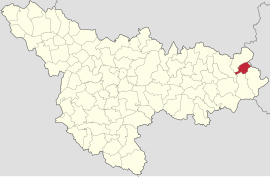Curtea
Curtea | |
|---|---|
 The old and new churches in Curtea | |
 Location in Timiș County | |
| Coordinates: 45°49′44″N 22°18′29″E / 45.829°N 22.308°E | |
| Country | Romania |
| County | Timiș |
| Government | |
| • Mayor (2020–2024) | Marinel Crăciunescu[1] |
Area | 44.38 km2 (17.14 sq mi) |
| Population (2021-12-01)[3] | 1,228 |
| • Density | 28/km2 (72/sq mi) |
| Time zone | EET/EEST (UTC+2/+3) |
| Postal code | 307135–307137 |
| Vehicle reg. | TM |
| Website | www |
Curtea (Hungarian: Kurtya; German: Kurtaa) is a commune in Timiș County, Romania. It is composed of three villages: Coșava, Curtea (commune seat) and Homojdia.
Geography
[edit]Curtea is located in the northeast of Timiș County, close to the border of Hunedoara County, 110 km (68 mi) from Timișoara, 45 km (28 mi) from Lugoj and 12 km (7.5 mi) from Făget, the nearest town. Curtea lies at the foothills of Poiana Ruscă Mountains, at the confluence of Valea Izvorașului with Valea Stâlpului, which, in fact, form the upper course of Bega River.[4]
History
[edit]The first recorded mention of Curtea dates from 1597 (Kurthe), when it belonged to Marzsina District, Hunyad County.[5] Legend has it that Curtea was once the summer residence of Romanian duke Glad, and Curtea took this name because Glad kept his entire court here (in Romanian curte means "court").[4] A Turkish possession by 1658, Curtea was a place of refuge for Transylvanian nemes (small and medium nobles) in conflict with the Hungarian royal house.[6] In Marsigli's notes from 1690–1700 it was called Kortya and belonged to Facset District, and in the 1717 census it appears as inhabited, with 50 houses.[6] The first Romanian school was established here in 1776.[6] The wooden church, which can still be seen today, dates from 1794.[7]
Demographics
[edit]Religious composition (2011)[9]
Curtea had a population of 1,193 inhabitants at the 2011 census, down 10% from the 2002 census. Most inhabitants are Romanians (94.05%), with a minority of Roma (2.1%). For 2.68% of the population, ethnicity is unknown.[8] By religion, most inhabitants are Orthodox (80.64%), but there are also minorities of Pentecostals (12.07%), Baptists (2.1%) and Adventists (1.59%). For 2.68% of the population, religious affiliation is unknown.[9]
| Census[10] | Ethnic composition | ||||
|---|---|---|---|---|---|
| Year | Population | Romanians | Hungarians | Germans | Roma |
| 1880 | 2,109 | 2,048 | 23 | 36 | – |
| 1890 | 2,158 | 2,088 | 41 | 15 | – |
| 1900 | 2,266 | 2,117 | 41 | 33 | – |
| 1910 | 2,399 | 2,290 | 65 | 17 | – |
| 1920 | 2,275 | 2,232 | 37 | 1 | – |
| 1930 | 2,215 | 2,106 | 20 | 9 | 73 |
| 1941 | 2,071 | 1,996 | 12 | 16 | – |
| 1956 | 1,927 | 1,911 | 5 | 6 | – |
| 1966 | 1,731 | 1,684 | 8 | 1 | 29 |
| 1977 | 1,656 | 1,593 | 4 | – | 57 |
| 1992 | 1,459 | 1,429 | 3 | 2 | 23 |
| 2002 | 1,323 | 1,275 | 7 | 2 | 36 |
| 2011 | 1,193 | 1,122 | 9 | – | 25 |
References
[edit]- ^ "Results of the 2020 local elections". Central Electoral Bureau. Retrieved 16 June 2021.
- ^ "Primăria Curtea". Ghidul Primăriilor.
- ^ "Populaţia rezidentă după grupa de vârstă, pe județe și municipii, orașe, comune, la 1 decembrie 2021" (XLS). National Institute of Statistics.
- ^ a b "Prezentare locală". Primăria comunei Curtea. Archived from the original on 2021-09-25. Retrieved 2021-09-25.
- ^ Szabó, M. Attila (2003). Erdély, Bánság és Partium történeti és közigazgatási helységnévtára. Miercurea Ciuc: Pro-Print Kiadó.
- ^ a b c "Fișa Primăriei comunei Curtea". Consiliul Județean Timiș.
- ^ "Biserica de lemn "Cuvioasa Paraschiva"". Biserici de Lemn din România.
- ^ a b "Tab8. Populația stabilă după etnie – județe, municipii, orașe, comune". Institutul Național de Statistică. Archived from the original on 2016-01-18. Retrieved 2021-09-25.
- ^ a b "Tab13. Populația stabilă după religie – județe, municipii, orașe, comune". Institutul Național de Statistică. Archived from the original on 2020-08-07. Retrieved 2021-09-25.
- ^ Varga, E. Árpád. "Temes megye településeinek etnikai (anyanyelvi/nemzetiségi) adatai 1880-2002" (PDF). Archived from the original (PDF) on 2007-06-10. Retrieved 2021-09-25.


